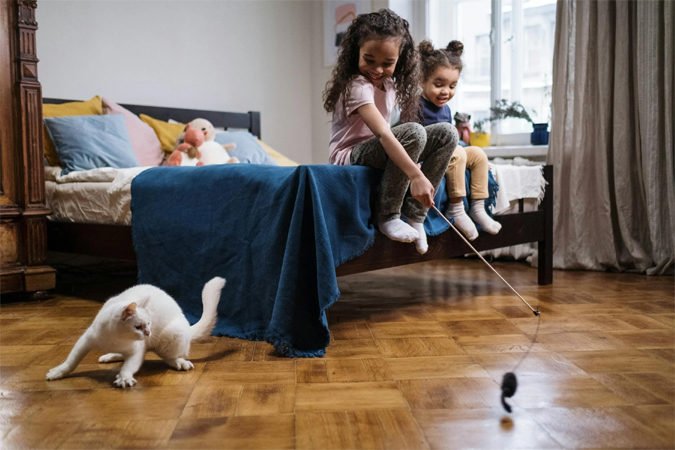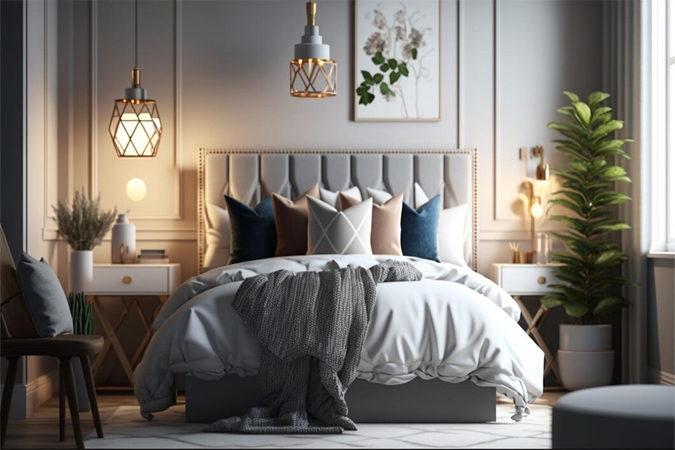Do you love your cat as much as you do yourself? Well, good care calls for one to have a cozy bedroom for your furry friend, which lets your pet sleep in, play, and chill in style and comfort. The bottom line is that having a cozy bedroom for your cat is absolutely what will boost the health, happiness, and comfort of your kitty.
In this blog, we will show how to create, in five simple steps, your cat’s bedroom: from choosing the location and the bed to adding comfort and decoration, to cleanliness and hygiene. By following these steps, one can build an amazing cozy bedroom for cats that will be enjoyed by both.
Easy Tips on How to Create a Cozy Bedroom for Cat
The truth is, creating a cozy bedroom for your cat is not that difficult at all. Set aside a place that is warm and inviting, where your cat can snuggle up and catch up on some good Zs. Immediately make it appealing with a plush pet bed or soft blankets tucked away in some quiet nook. Cats like to snuggle up into soft fabrics. Think about cozy throws or cushions that can also be added to your bed or favorite chair.
Another major factor in making your cat comfortable is lighting. A cozy bedroom lighting can add much to the welcoming atmosphere. Cats love sitting in the sun, and if you have a window, make a little perch for them or lay a blanket for them there-it’ll be their cozy nook. This small touch can boost your cat’s mood and add warmth to your bedroom environment. If your space doesn’t allow for natural light, you can still create a relaxed, cozy vibe by choosing a soft, warm lamp. These cat bedroom ideas not only enhance your pet’s comfort but also make your room feel more inviting overall.
Add a few interactive cat toys or a scratching post to enhance your cat’s activities and keep them amused. The hidden places, like a cat tunnel or a blanket draped over a chair, will give your cat the room to retreat into and a feeling of safety.
Finally, keep your room clean and uncluttered. Cats are curious explorers, and a neat room will promote free movement, making them feel more secure and at ease. By following these tips on how to create a cozy bedroom, you’ll craft a welcoming space that both you and your cat will love. Apply these simple points, and you’ll be well on your way to achieving a cozy bedroom for both cat and owner.
What is a Cozy Bedroom for Your Cat?
Your cat’s bedroom should be inviting, comfortable, and cozy for rest and relaxation for both your cat and you. This is not just a matter of setting aside a nook or a corner and dumping their bed there. You’re truly going to tailor an area specifically to their needs and likes.
Why would you want to take so much time out of your day learning how to create a cozy bedroom by designating and decorating a whole room for your kitty? There are many benefits to creating a cozy cat bedroom:
- Strengthens Bond: Designing a special space just for your cat shows how much you care about their happiness and comfort. In turn, this strengthens attachment and trust.
- Provides Retreat: Cats appreciate having ‘alone time’ and a quiet space they can retreat to, just like humans. A designated bedroom gives them this privacy.
- Reduces Stress: The familiarity and security of their own space lower anxiety for rescued, elderly, or nervous kitty’s. Knowing they have a safe den helps cats relax.
- Improves Sleep: Cats sleep an average of 12-14 hours per day. Having a room tailored to their sleeping requirements results in better quality rest.
- Enhances Overall Well-being: The safety of a snug bedroom satisfies a cat’s nesting instinct. With needs met, cats have better behavioral and emotional health.
Choosing the Right Location
Not all areas of your home make good bedrooms for cats. When exploring cat bedroom ideas and deciding on a spot, keep factors like natural light, safety, and comfort in mind. Look for spaces that allow for cozy bedroom lighting and consider elements seen in popular cat rooms in houses to create a perfect environment.:
- Noise Level: As cats have sensitive hearing, it’s important to situate their bedroom away from loud areas like TV rooms. Choose basement rooms or spare upstairs bedrooms to reduce disruptive noises. Check for outside factors like patio door proximity or speaker locations too.
- Comfort: Hard floors are tough on cat joints and paws when lounging for long periods. Opt for carpeted rooms or lay down soft blankets, rugs, or beds to cushion the space. Keep heating or cooling consistent with the rest of your home for year-round comfort.
- Safety: Ensure your cat’s bedroom allows you to close doors and restrict stairs for when you are out. Unplug and secure cords or hazardous household objects. Install baby gates if needed to block other pets. Consider visibility and ease of monitoring your cat in their room.
- Access: While a private sanctuary, the bedroom should be conveniently accessed multiple times per day. If on a different floor level, ensure stairs are safe to use or install ramps for elderly or disabled cats.
- Lighting: The quantity and quality of lighting impact the coziness of a room. Bright glaring bulbs are not restful. Use lamp lighting, blackout curtains, or under-bed lighting to control brightness suitable for sleep and play.
How to Pick a Cat Bed

The right bedding is essential to ensure your cat has a snuggly place to loaf in their new bedroom. When exploring cat bedroom ideas or cat room ideas for small spaces, assess these aspects when shopping for cat beds: size, material, and comfort. For inspiration, take cues from popular cat rooms in houses that combine functionality with style.
- Size: Measure your cat asleep from head to tail. Size the bed about 2 inches wider and longer. Giant breeds may need multiple mattresses pieced together. For a kitten, leave ample growing room.
- Shape: Consider your cat’s sleep style. Curled sleepers do well in round, high-walled nest beds. Sprawlers need a flat, rectangular mattress design with bolsters only at the edges.
- Firmness: Although personal preference varies per pooch, older cats generally need thick orthopedic foam for joint support. Kittens and smaller breeds often enjoy sinking into plush pillow-tops. Test beds in the store by pressing into the center – slight indentation means it’s supportive yet cozy.
- Material: Fur clinging to fabrics causes extra work for pet owners. For less shedding and easy cleaning choose smooth microsuede or tightly woven canvas covers.
- Washability: Almost all quality beds have removable covers or inserts that can be machine washed and air dried. Check that zippers are sturdy and fabrics preshrunk and colorfast so beds look fresh after laundering.
How to Make Your Cat Feel at Home
Beyond beds, incorporating cat bedroom ideas like cozy blankets, soft pillows, and a few toys can make their new bedroom more welcoming. For those looking into cat room ideas for small spaces, adding vertical climbing options or wall-mounted shelves can create more room for play and relaxation. Take inspiration from cat rooms in houses to craft an environment that feels both stylish and comfortable for your feline friend.
Blankets – Layer old t-shirts, fleece throws, or leftover towels to create snuggly nesting spots, encouraging cats to snuggle in. Use worn items carrying your scent for comfort and security when you’re not around.
Pillows – Fluff bedding with oversized pillows in washable cases. Place against walls for back support or use to prop up heads and paws for ultimate lounging. Stash extra pillows out of the way until you rotate them into the bed.
Toys – Rotate plush toys weekly to keep playtime varied and interesting. Hide treats inside puzzle toys enabling ‘hunting’ even while cooped up indoors. Arrange rope toys, tug rings, and fetch balls nearby to inspire movement and exercise too.
Treats – Make an easily accessed treat tin part of the room’s decor. Come visit time, grab a few biscuits or healthy dental sticks to munch while bonding.
Water & Food Bowls – For convenience, designate corner space for a water bowl, refilling it often so it stays fresh. Place food mats underneath to catch spills. In a separate area, feed smaller meals in snout-level bowls to prevent gorging.
How to Incorporate Your Cat’s Personality into the Room Design
When decorating their bedroom, don’t forget your cat has likes and dislikes too. If you’re exploring simple cat room ideas or cat room ideas for small spaces, jazz up the space in ways that are pleasing to your pet. Consider adding cozy bedding, interactive toys, and scratching posts that cater to their preferences. When learning how to create a cozy bedroom, always focus on elements that make your feline feel secure and happy.
Colors – Notice what color toys or beds your cat prefers. Use matching color schemes in decor details like wall paint, window treatments, floor rugs, or decorative pillows. Soothing cool hues of blue, green, and gray make restful palettes.
Photos – Frame and arrange photos of your cat alone or with family members to make them feel included and important. Group shots showcasing adventures trigger happy memories.
Accessories – Wall hooks and racks neatly stow leashes, raincoats, or sweaters. Baskets or storage ottomans hide mess out of sight. Cork boards display ribbons from past competitions or shows. Pick organizers suiting your cat’s interests and personality.
Cat Interests – Decorate using motifs your cat enjoys. For example, rural countryside scenes for hunting breeds, bones, or paw prints for playful young cats, or cityscapes for jet-setting urban kitty’s. Buy artwork showcasing your cat’s breed or name to personalize further.
How to Keep Your Cat’s Room Fresh
To benefit fully from a dedicated cat bedroom, stay diligent with cleaning routines. Whether you’re following cat room ideas for small spaces or designing larger cat rooms in houses, maintaining cleanliness is key to creating a space your pet will love. Regular cleaning helps keep the room fresh and inviting, aligning perfectly with the goal of how to create a cozy bedroom for your feline friend.
Air Flow – Keep air circulating through open doors, cracked windows, or fans. Limit carpeting which holds odors. Change HVAC filters monthly. Consider air purifiers to trap smells, dander, and hair.
Wash Bedding – Every 2 weeks, strip bedding, launder covers, rinse insert foam, and dry thoroughly. More frequent laundering may be needed for anxious kitty’s or incontinent, unwell, or elderly cats.
Accidents – Invest in an enzymatic cleaner and blacklight to fully erase urine stains and smells. Spot treat accidents immediately after noticing them. Carpet clean every few months depending on usage and condition.
Vacuuming – Dry shampoo large cats outdoors then follow up with thorough robotic or upright vacuuming twice weekly focusing on bed spots and floor corners where shed fur gathers. Empty robot bins after every use.
Grooming – Brush cats outdoors every few days to control shedding and dander buildup. Trim excess fur growth around ears, paws, and rear ends if needed. Schedule professional de-shedding treatments seasonally.
Conclusion
Establishing a dedicated bedroom tailored just for your cat takes effort yet yields many rewards. Whether you’re learning how to create a cozy bedroom for your furry friend or exploring unique cat bedroom ideas, having a special space can offer your pet comfort and security while providing you with valuable one-on-one time to nurture your bond. Keeping up with regular cleaning and adding thoughtful touches like cozy bedroom lighting encourages healthy ownership habits, from grooming and playtime to training interactions that benefit your cat’s well-being.
Most importantly, watching your cat contentedly lounging in their new favorite spot – happily surrounded by familiar scents, soft bedding, and cherished toys – helps you see your home from their perspective. Incorporating elements found in popular cat rooms in houses can strengthen the bond between you and your cat. Offering such creature comforts will ultimately improve their quality of life as a beloved family member.



